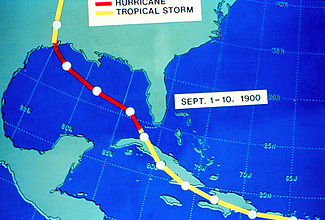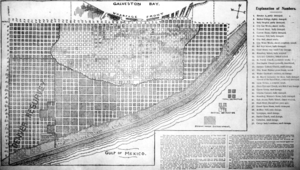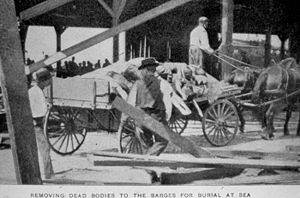1900 Galveston hurricane
In addition to the number killed, the storm destroyed about 7,000 buildings of all uses in Galveston, which included 3,636 demolished homes; every dwelling in the city suffered some degree of damage.In response to the storm, three engineers designed and oversaw plans to raise the Gulf of Mexico shoreline of Galveston Island by 17 ft (5.2 m) and erect a 10 mi (16 km) seawall.The extratropical system strengthened while accelerating across the Midwestern United States, New England, and Eastern Canada before reaching the Gulf of Saint Lawrence on September 13.Hurricane-force winds and storm surge inundated portions of southern Louisiana, though the cyclone left no significant structural damage or fatalities in the state.Farther north, the storm and its remnants continued to produce heavy rains and gusty winds, which downed telegraph wires, signs, and trees in several states.[9] The first formal sighting of the tropical storm occurred on August 27, about 1,000 mi (1,600 km) east of the Windward Islands, when a ship encountered an area of unsettled weather.[5][8] Over the next couple of days, the system moved west-northwestwards and is thought to have maintained its intensity as a weak tropical storm, before it passed through the Leeward Islands and entered the Caribbean Sea on August 31.[5] On September 1, Father Reese Gangoite, the director of the Belen College Observatory in Havana, Cuba, noted that the storm was in its formative stages, with only vague indications of a small tropical cyclone to the southwest of Saint Croix.[5] As the system emerged into the Straits of Florida, Gangoite observed a large, persistent halo around the moon, while the sky turned deep red and cirrus clouds moved northwards.[11] However, the United States Weather Bureau (as it was then called) disagreed with this forecast, as they expected the system to recurve and make landfall in Florida before impacting the American East Coast.[11][12] An area of high pressure over the Florida Keys ultimately moved the system northwestward into the Gulf of Mexico, where favorable conditions such as warm sea surface temperatures allowed the storm to intensify into a hurricane.[5][11] In the eastern Gulf of Mexico on September 6, the ship Louisiana encountered the hurricane, and its captain, T. P. Halsey, estimated that the system had wind speeds of 100 mph (160 km/h).On September 7, the system reached its peak intensity with estimated sustained wind speeds of 145 mph (235 km/h), which made it equivalent to a Category 4 hurricane on the modern-day Saffir–Simpson scale.[11] The hurricane weakened slightly on September 8 and recurved to the northwest as it approached the coast of Texas, while the Weather Bureau office in Galveston began observing hurricane-force winds by 22:00 UTC.[16][17] The city was the fourth largest municipality in terms of population in the state of Texas in 1900, and had among the highest per capita income rates in the U.S.[18] Galveston had many ornate business buildings in a downtown section called The Strand, which was considered the "Wall Street of the Southwest".[19] The city's position on the natural harbor of Galveston Bay along the Gulf of Mexico made it the center of trade in Texas, and one of the busiest ports in the nation.[14] If a similar storm struck in 2010, damage would total approximately US$104.33 billion (2010 USD), based on normalization, a calculation that takes into account changes in inflation, wealth, and population.[26] However, many communities outside of Galveston also suffered serious damage and it caused many casualties and affected many families economically,[46] with several cities reporting a near or complete loss of all buildings or homes, including Alta Loma, Alvin,[60] Angleton,[61] Brazoria, Brookshire,[60] Chenango,[62] El Campo,[61] Pearland,[60] and Richmond.[26] The disaster did not even spare the buried dead; a number of coffins, including reportedly that of actor-playwright Charles Francis Coghlan who had died in Galveston the previous year, were washed out of the local cemetery to sea by the tidal storm surge.[102] In Brooklyn, The New York Times reported that trees were uprooted, signs and similar structures were blown down, and yachts were torn from moorings with some suffering severe damage.Waves breached the sand dunes at multiple locations along the cape, with water sweeping across a county road at Beach Point in North Truro.The majority of loss of life in Canada occurred due to numerous shipwrecks off the coasts of Saint Pierre and Miquelon, Newfoundland, and Prince Edward Island.The CRC was composed of subcommittees for specific aspects of relief efforts, including burial of the deceased, correspondence, distribution of food and water, finances, hospitalization and rehabilitation for the injured, and public safety.[124] With thousands dead and roughly 2,000 survivors leaving the city and never returning according to a Morrison and Fourmy Company survey, Galveston initially experienced a significant population decline.Cohen, Schiff, and others created the movement to draw Jewish immigrants away from the crowded area along the East Coast and toward cities farther west, such as Galveston.[126] In the months prior to the hurricane, valet Charles F. Jones and lawyer Albert T. Patrick began conspiring to murder wealthy businessman William Marsh Rice in order to obtain his wealth.Overall, 258 barrels, 1,552 pillow cases, and 13 casks of bedding, clothing, crockery, disinfectants, groceries, hardware, medical supplies, and shoes were received at the warehouse, while $17,341 in cash was donated to the Red Cross.[126] Despite the seawall, Ike left extensive destruction in Galveston due to storm surge, with preliminary estimates indicating that up to $2 billion in damage occurred to beaches, dwellings, hospitals, infrastructure, and ports.The most important long-term impact of the hurricane was to confirm fears that Galveston was a dangerous place to make major investments in shipping and manufacturing operations; the economy of the Golden Era was no longer possible as investors fled.[149] The last reported survivor of the Galveston hurricane of 1900, Maude Conic of Wharton, Texas,[152] died November 14, 2004, at the claimed age of 116, although the 1900 census and other records indicate she was about 10 years younger than that.
Map key
Tropical depression (≤38 mph, ≤62 km/h)
Tropical storm (39–73 mph, 63–118 km/h)
Category 1 (74–95 mph, 119–153 km/h)
Category 2 (96–110 mph, 154–177 km/h)
Category 3 (111–129 mph, 178–208 km/h)
Category 4 (130–156 mph, 209–251 km/h)
Category 5 (≥157 mph, ≥252 km/h)
Unknown
Tropical storm (39–73 mph, 63–118 km/h)
Category 1 (74–95 mph, 119–153 km/h)
Category 2 (96–110 mph, 154–177 km/h)
Category 3 (111–129 mph, 178–208 km/h)
Category 4 (130–156 mph, 209–251 km/h)
Category 5 (≥157 mph, ≥252 km/h)
Unknown
Storm type








Galveston hurricane (disambiguation)ExtratropicalDeadliestfourth-deadliest Atlantic hurricaneLesser AntillesGreater AntillesDominican RepublicTurks and Caicos IslandsBahamasGulf Coast of the United StatesMidwestern United StatesMid-AtlanticNew EnglandEastern Canada1900 Atlantic hurricane seasonnatural disasterUnited States historyUnited StatesGalvestonstorm surgeinundatedcoastlinethe islandAtlantic hurricaneHurricane FifiinvestorsHoustonGulf of MexicoGalveston IslandseawallWindward IslandslandfallHispaniolaSantiago de Cuba ProvinceCategory 4maximum sustained windsGulf of Saint LawrenceNewfoundlandSouth FloridaLouisianatelegraphIllinoisNew YorkMassachusettsMissouriOntarioFrench territorySaint-PierreSaffir–Simpson scaleTropical cycloneSubtropical cycloneExtratropical cyclonetropical waveAfricaAtlantic Oceanmeteorologiststropical stormweatherLeeward IslandsCaribbean SeaBelen College ObservatoryHavanaSaint CroixPuerto RicoWindward PassageSaint-MarcSantiago de CubaStraits of Floridacirrus cloudsUnited States Weather BureauFloridaAmerican East Coastarea of high pressureFlorida Keyssea surface temperaturesWeather BureauWillis Luther MooreWest BayHistory of Galveston, Texasboomtownper capita incomeThe StrandWall StreetGalveston BaybelievedIsaac ClineGalveston Daily NewsIndianolaMatagorda Baypowerful hurricanesecond hurricane in 1886sandbarGulf CoastSand dunesWashington, D.C.tropical disturbancetornadoforecastersmeteorological observatoryColegio de BelénSpanish–American Warstorm warningsCedar KeySavannahGeorgiaCharlestonSouth CarolinaKitty HawkNorth CarolinaPensacola, FloridaNew Orleanscentral TexasSan AntonioswellsauthorErik Larsonsevere thunderstormSan JuanBritish poundsDaiquiríTrinidadU.S. occupation government"San Ciriaco""Okeechobee""Cheniere Caminada"Katrina